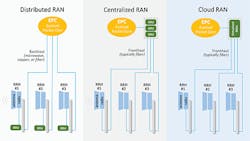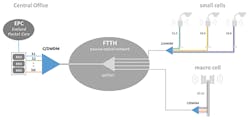How to Build the Foundation for 5G: C-RAN
Mobile operators preparing to support Gigabit LTE and ultimately 5G must make their networks much denser to deliver high-throughput, low-latency services. Densification involves deploying small cells every few hundred feet throughout the radio access network (RAN), or splitting existing macro cell site sectors to add capacity, among other options. C-RAN is an enabling architecture for the RAN — both for small cells and macro sites — that lays the foundation for 5G. And C-RAN is a major trend in the wireless industry today.
The C in C-RAN can stand for either "centralized" or "cloud" RAN, although in this article I’ll primarily focus on the centralized step, because that’s what operators are doing now. China Mobile has been at the forefront of this network architectural change, deploying it for the last few years. Other network operators are actively deploying C-RAN now, especially in the US with an eye towards increasing their commitment as the market matures.
In a traditional macro cellular network, remote radio heads are mounted at the top of the tower with the antennas, with fiber typically linking them to a baseband unit (BBU) situated at the base of the tower. The BBU is the radio equipment that processes billions of bits of information an hour and links the end-user to the core network. Every cell site has its own BBU located on-site in some type of shelter or enclosure.
Figure 1. CRAN Architecture.
C-RAN provides a more elegant and efficient alternative. (See Figure 1.) C-RAN pulls the BBUs off each site and centralizes them in a BBU pool, or C-RAN hub as it is also known. The C-RAN hub itself can serve a large number of cell sites and replaces the traditional BBUs located at each site. The total amount of BBU equipment required is reduced as some resource pooling is possible, and centralized RAN paves the way for the eventual major shift to Cloud RAN. In Cloud RAN, the BBU processing has been virtualized, enabling high utilization resource pooling with each virtual BBU servicing 30 or more cells. This version of C-RAN is expected to be a fundamental enabler for 5G. But before virtualization comes centralization, and that’s where the wireless industry is now.
The Future Is Fiber
By centralizing the BBUs at a C-RAN hub, a new layer is introduced into the network known as fronthaul. Fronthaul is the link between the BBU pool and the remote radio heads back at the cell site or the small cell location. Fiber is the best option for this because it offers more bandwidth, but there will always be a place for microwave links to be used, depending on the location. Because of the cost and challenge in laying new fiber, however, and also to maximize existing resources, some network operators are utilizing their existing fiber assets, such as a fiber-to-the-home (FTTH) network, with a technique called fiber network convergence.
Fiber network convergence refers to the combination of multiple services within a single access network. In other words, a single pipe is used to deliver all or multiple forms of communication services. Many large incumbent service providers have both wireline and wireless operations, so converging onto a single network and maximizing asset utilization makes excellent business sense. The process of fiber network convergence is primarily driven by the development of enabling technologies, user demand, and the service providers’ capabilities.
FTTH networks have an extensive footprint that is perfect for supporting fast-growing mobile applications such as distributed antenna system (DAS), small cell and Wi-Fi backhaul and/or C-RAN fronthaul. To get maximum usage out of their existing fiber assets, operators are using wave division multiplexing (WDM) over existing fiber to get 8, 16, or even 40 channels over a single fiber. The more channels that run over a fiber, the lower the overall costs. (See Figure 2.)
Figure 2. WDM Architecture.
WDM is a method of combining or separating multiple wavelengths of light in (MUX) or out (DE-MUX) of a single strand of fiber, with each wavelength of light carrying a different signal. In so-called passive WDM, the use of optical filters allows a pre-determined range of wavelengths and lets another range of wavelengths pass through via thin-film filter technology. Thin layers are stacked together, and consecutive reflections on the interfaces between these layers create interference effects that let light pass through for certain wavelengths and reflect others.
Passive WDM technology is a great fit for C-RAN fronthaul networks as it eliminates the need for an active optical transport layer to handle the wavelengths — and hence reduces electrical power requirements, an important factor for small cell deployments. With passive WDM, a service provider can deliver a wider range of services, adopt new business models, offer innovative services, and enter new markets using existing FTTH networks.
The C-RAN Advantage
C-RAN provides lots of advantages including less capital expenditures, lower maintenance costs, and better space utilization. C-RAN makes it less costly to maintain BBUs at a central location because operators don’t need truck rolls to each cell site. They can often leverage existing central office or cell site infrastructure to create the C-RAN hubs. In addition to creating savings on hardware costs, the C-RAN model can create significant savings in terms of power, cooling and site leasing costs. In Asia, the first region to successfully deploy C-RAN commercially, operators have seen operating expenditures (OpEx) drop 30% to 50%.*
The first step in the journey toward 4.5G and 5G is centralizing the RAN. Operators are doing this today by creating centralized BBU pools and leveraging their fiber networks to provide fronthaul from the cell sites to the BBU pools.
The next step in the process will be virtualization. Virtualization is already being deployed in the core of the network, but it will eventually flow out to the RAN, too.
When C-RAN comes to mean Cloud RAN, then we really will see some exceptional service levels in wireless networks. Operators recognize this and are taking steps now, in the form of centralization, to get there.
Endnote:
*See the China Mobile Research Institute white paper, C-RAN: The Road Towards Green RAN, version 2.5, October 2011 at http://labs.chinamobile.com/cran/wp-content/uploads/CRAN_white_paper_v2_5_EN.pdf (page 37).
Save
Save
Save
About the Author



